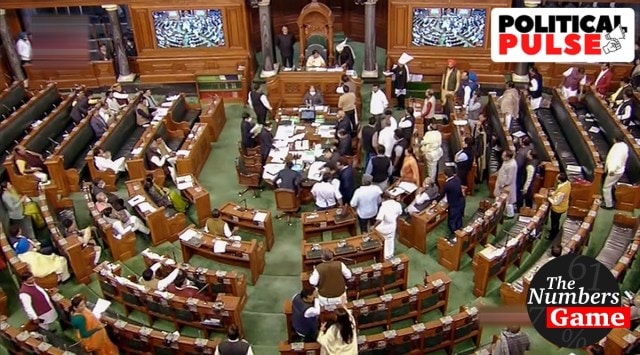The Numbers Game | Winter Session may conclude today: How productive were our MPs this time?
The session saw heated debates over China’s transgressions in Tawang in Arunachal Pradesh, with the Opposition taking on the Centre over the lack of a discussion on the matter. Here is a look at Parliament’s productivity rate till December 21 and a comparison with the productivity rate in previous sessions of the 17th Lok Sabha.
 Till Wednesday, the Lok Sabha clocked a 103 per cent productivity rate and the Rajya Sabha 100 per cent, according to non-profit PRS Legislative Research. View of the Lok Sabha during the ongoing Winter Session of Parliament, in New Delhi, Thursday, Dec. 22, 2022. (PTI Photo)
Till Wednesday, the Lok Sabha clocked a 103 per cent productivity rate and the Rajya Sabha 100 per cent, according to non-profit PRS Legislative Research. View of the Lok Sabha during the ongoing Winter Session of Parliament, in New Delhi, Thursday, Dec. 22, 2022. (PTI Photo) The Winter Session of Parliament, which started on December 7, is expected to conclude on Friday. The session saw heated debates over China’s transgressions in Tawang in Arunachal Pradesh, with the Opposition taking on the Centre over the lack of a discussion on the matter and deeming it a “national concern”.
The session also saw amendments to the Constitution Scheduled Tribes (Order), 1950, being passed, among others. Some of the other Bills that were passed are the Wild Life (Protection) Amendment Bill, 2021, the Energy Conservation (Amendment) Bill, 2022, and the Anti-Maritime Piracy Bill, 2019. A viral moment from the House came when Trinamool Congress MP Mahua Moitra laid into the government, asking, “Who’s the Pappu now?”
Till Wednesday, the Lok Sabha clocked a 103 per cent productivity rate and the Rajya Sabha 100 per cent, according to non-profit PRS Legislative Research. The final numbers are likely to change when the last few days of the session are accounted for.
Here is a look at the productivity rates of the various Parliament sessions since the BJP returned to power in 2019.
Budget Session 2019 (June 17 to August 7)
Lok Sabha productivity: 135 per cent
Rajya Sabha productivity: 100 per cent
The first session to be held after the Lok Sabha elections that year, the session saw a high productivity rate. Article 370 was abrogated during this session and triple talaq Bills were passed.
Winter Session 2019 (November 18 to December 13)
Lok Sabha productivity: 111 per cent
Rajya Sabha productivity: 92 per cent
The productivity remained high. This Session saw 10 Bills being passed, including the Citizenship (Amendment) Bill.
Budget Session 2020 (January 31 to March 23)
Lok Sabha productivity: 86 per cent
Rajya Sabha productivity: 74 per cent
Apart from the Citizenship Amendment Act (CAA), the session was marked by heated discussions about the abrogation of Article 370 a year earlier, the proposed National Register of Citizens, and the violence and police action on the Jawaharlal Nehru University campus in New Delhi.
Monsoon Session 2020 (September 14 to September 23)
Lok Sabha productivity: 145 per cent
Rajya Sabha productivity: 99 per cent
This session was marked by protests against the passing of the Farmers’ Produce Trade and Commerce (Promotion and Facilitation) Bill and Farmers (Empowerment and Protection) Agreement on Price Assurance and Farm Services Bill in the Rajya Sabha. The Opposition’s demand that the Bills be referred to a Select Committee was ignored.
Winter Session 2020
It was not held due to the Covid-19 pandemic.
Budget Session 2021 (January 29 to March 25)
Lok Sabha productivity: 107 per cent
Rajya Sabha productivity: 90 per cent
This session had to be curtailed due to demands by political parties in both Houses “so that Members could participate in the election process in certain States/UTs”. PRS noted that Question Hour — the first hour where MPs can raise questions — functioned for just a little over 50 per cent of the time in both Houses. None of the Bills was referred to committees. 76 per cent of the Budget was passed without discussion, PRS data said.
Monsoon Session 2021 (July 19 to August 11)
Lok Sabha productivity: 21 per cent
Rajya Sabha productivity: 29 per cent
The session, originally scheduled from July 19 to August 13, ended two days before schedule due to protests in both Houses over the Pegasus snooping scandal, agitation by farmers, and the rise in prices. In its report on the session, PRS noted, “Parliament functioned for less than a quarter of the scheduled time, and several Bills were passed within minutes, without any discussion.”
Winter Session 2021 (November 29 to December 22)
Lok Sabha productivity: 77 per cent
Rajya Sabha productivity: 43 per cent
The session was dominated by a debate on the contentious farm laws that the Narendra Modi government had withdrawn in November 2021. The Farm Laws Repeal Bill was passed by the two Houses via voice vote without any discussion, as the Opposition protested. At least three Opposition MPs claimed they had got “unsatisfactory replies” from Treasury benches and spoke of BJP MPs’ “inability” to address questions directly in the Lok Sabha.
Budget Session 2022 (January 31 to April 7)
Lok Sabha productivity – 123 per cent
Rajya Sabha productivity – 90 per cent
PRS noted that seven Bills were introduced in the session (excluding the Appropriation and Finance Bills), less than half of the average of 15 Bills introduced across Budget sessions since 2009. Five Bills were passed, of which one was pending from the previous session (the Chartered Accountants Bill).
Monsoon Session 2022 (July 18 to August 8)
Lok Sabha productivity: 47 per cent
Rajya Sabha productivity: 42 per cent
The session ended three days before schedule amid protests by the Opposition over issues such as price rise, the Agnipath scheme, and the alleged misuse of central probe agencies by the Centre.
The two Houses held only 16 sittings each. In terms of the number of sittings, this was the second-shortest session of the 17th Lok Sabha.































